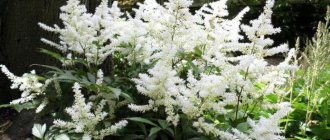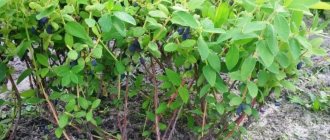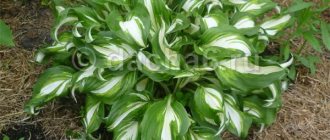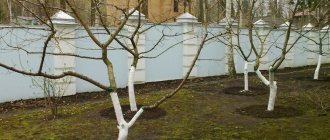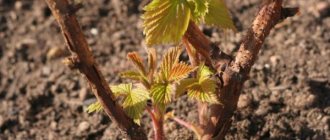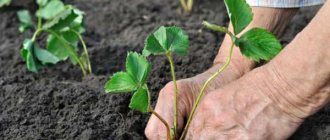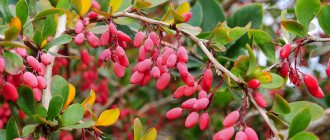A detailed description of the process of transplanting barberry in the fall. Tips for beginners
Barberry bushes, exquisitely beautiful, especially in the autumn, are grown for two reasons: high decorativeness (for example, barberry Thunberg and barberry coinifolia) and the practical use of berries in cooking or other parts of the plant for medicinal purposes (B. vulgaris). A situation arises from time to time , which requires replanting the bush, and gardeners are faced with the question - when to replant barberry in spring or autumn? In this article we will determine the best time to plant a shrub in a new location and study the details of the process.
Care and pruning of barberry in autumn for beginners
Barberry is a unique garden shrub that combines equally decorative and consumer qualities. The berries of many of its varieties are tasty and healthy, and the bushes have a beautiful appearance and can truly decorate the garden. Pruning barberry in the fall is an integral part of the work package for caring for this thorny shrub. It is the key to maintaining an attractive appearance and good productivity.
The photo below shows barberry in autumn.
When to replant
The advantage of spring replanting is that there are many warm days ahead; the bush will have time to take root in a new place and grow new shoots, although flowering and fruit set will be reduced.
Gardeners often postpone the process until the fall - there is enough time from the beginning of leaf fall to the onset of the final cold weather. In order for the plant to quickly settle into a new place, it is transported with a lump of earth. During the remaining warm days, the barberry will strengthen in the soil, and in the spring it will begin to develop as usual.
Description of barberry
This plant belongs to the Berberidaceae family. Barberry has amazing healing properties. Its fruits, foliage and even bark are used in folk medicine. Africa is considered the birthplace of the tree. Later, the culture appeared in Europe, and from there it migrated to Russia.
Externally, the plant is a shrub whose height reaches 4 meters. Foliage in the form of bunches of thorns. The inflorescences of the crop are yellow and resemble tassels. Once they are fertilized, they transform into red fruits. The foliage of the plant is often affected by “rust”. This disease is very difficult to fight. The cause of this unpleasant defect is the barberry aphid, which received its name because of its reddish tint. It affects the lower parts of the foliage. If you do not get rid of parasites in a timely manner, the insects will begin to multiply quickly, which will cause great harm to the plant and it will suffer greatly. It can even lead to complete loss of leaves and curvature of shoots. Therefore, every spring you need to carefully inspect thorny bushes.
Preparing for transplant
Before proceeding directly to transplanting the plant, a place on the site is selected and prepared for it. We will tell you how to do this correctly below.
It is advisable to trim heavily overgrown bushes:
- during the digging process, part of the root system will be cut off; if there are a large number of shoots, an excessive load will fall on it, and it may not “pull out”;
- long thorny branches create inconvenience when digging and transporting the bush.
The planting pit is prepared three weeks in advance, perhaps 1-2 days before planting. The dimensions are determined based on the age of the barberry being transplanted:
- For seedlings no older than 3 years, the pit dimensions are 0.25x0.25x0.25 m.
- For a bush from 4 to 7 years old, the minimum is 0.5x0.5x0.5 m.
- For a hedge, trenches are dug 40 cm deep and 40-50 cm wide. The length is calculated according to the number of seedlings. It is optimal to plant 2-4 bushes on each linear meter.
Fertilizers are added to the holes:
- humus + sand or garden soil + compost in a 1:1 ratio;
- wood ash, which also protects against fungal diseases;
- superphosphate and potassium salts mixed with soil.
The bottom of the pit must be covered with a drainage layer of dry leaves, sawdust, medium-fraction pebbles, etc.
Choosing a new place
For planting barberry, choose a well-lit area. The shrub can grow in the shade, but will not bear fruit. Without proper lighting, the decorative value of foliage tends to zero.
“When barberry is planted alone, it will look advantageous at a distance of about 2 meters from other plants.”
Stagnant water is contraindicated for shrubs. At the planting site, groundwater should lie at a depth of at least one and a half meters. If possible, plant at higher elevations.
Is it possible to plant barberry in a low-lying area? It’s better not to take risks; rain or melt water will accumulate here. Soil requirements:
- ideal option - loams or chernozem, clay or sandy soils must be optimized by making appropriate additions;
- the pH value should be in the range of 6...7; excessively acidic soil is treated with any deoxidizing agent during planting.
Planting barberry at home
Barberry is propagated by cuttings, root suckers, dividing bushes, and also by seeds. However, growing barberry from seeds is a very long process; it is much faster to propagate it vegetatively from an adult bush. If you nevertheless decide to grow barberry from seeds, then you should remember that its seed shell is very hard, so you must first soak them in sand or peat (stratify) at a temperature of +5 degrees for 2-5 months. If you sow barberry in the fall, immediately after removing the seeds from the berries, they will undergo natural stratification in the soil. In summer, the seeds will sprout vigorously. After two true leaves appear, the planting needs to be thinned out. The seedlings will grow in one place for two years, then they must be transplanted to a permanent place.
Barberry loves a bright place in the garden, although it tolerates partial shade. However, if you plant it in the shade, it will not bear fruit at all. For a hedge, the plant should be planted 1 meter apart, and if it is a single planting, then the distance to other plants should be at least two meters.
We recommend reading
How to plant coffee beans
How to plant kiwi at home
How to grow calla lilies at home
How to plant mangoes from seeds at home photo
The soil for planting barberry must be fertilized and well drained so that there is no stagnation of water, then caring for it will be easy. Before planting barberry seedlings in the fall, the soil must be dug to a depth of 60 cm and cleared of weeds. For a hedge, you will need to dig a trench. We first fill the planting holes with a fertile layer of soil, and then add fertilizer: organic matter, potassium salt, superphosphate. To prevent the roots of the seedling from coming into contact with the fertilizer, it must be mixed well with the soil. If the soil is acidic, then ash or lime should be added to the hole. Then we plant the seedling, straightening all its roots, cover it with earth and compact it well. Then we water, mulch with peat or humus and cut the shoots to 3-4 developed buds.
Transplantation process
The following algorithm shows how to properly transplant an adult barberry bush to a new location:
- It's better to choose a cloudy day. In sunny weather, bushes are dug up early in the morning or late in the evening. The day before transplanting, pour plenty of water - this makes it easier to remove it from the ground, and the roots will be less damaged.
- Barberry is dug around the perimeter of the crown. Then the earthen lump is cut off with a shovel bayonet.
- Lifting the bush on each side, cut off its roots.
The extracted bush, together with a lump of earth, is transferred to the planting hole. It is advisable to use thick film, linoleum or tarpaulin for carrying: the plant is strewn with thorns, and it is uncomfortable to carry it in your arms.
Just before planting, a clod of earth is spilled with Epin or another stimulant. The places where the roots are cut are sprinkled with “Kornevin” or its equivalent. This will allow the root system to quickly recover from stress. A barberry bush with a lump of earth is carefully placed in a hole spilled with water, and the gaps are filled with the prepared soil mixture. Then water it abundantly, after which the soil is added.
The exposed roots of seedlings are straightened when planting. Backfilling is carried out gradually, compacting the soil. The tree trunk circle is covered with peat or compost on top to better preserve moisture and looseness of the soil. The planting is completed by pruning: leaving 3-5 buds, the most developed and promising ones.
Description, reproduction and distribution area of the common barberry
A thorny and deciduous shrub from the barberry family, the plant height does not exceed three meters.
The shrub is highly branched and has a strong superficial root system. Old branches of the plant have gray bark, but the bark of young branches is yellow-brown or yellowish-gray.
The branches of barberry are thin, sometimes with simple spines, and you can find a barberry bush with tripartite spines (there are buds in their axils). Small branches with leaves emerge from the buds.
The leaves of the plant are oblong in shape, with spiny cilia located on the edges of the leaves.
Barberry flowers emit a strong aroma, the color of the flowers is light yellow. Flowers numbering 15–25 are collected in drooping axillary racemes.
The barberry fruit is a dark red berry. The berry is very juicy and has several seeds. The weight of the barberry fruit does not exceed 4 grams.
The seeds are dark brown in color, have a flattened shape, and fine wrinkles.
Barberry flowering begins in May and lasts until June. Fruit ripening occurs between July and October.
Distributed in the southern regions of our country, in the middle zone it is grown as an ornamental plant. Loves dry sunny areas.
Features of transplanting barberry in autumn
Do you know the taste of “Barberry” candies? That's right, it's the same for berries. The culture is quite attractive, unpretentious and frost-resistant, quickly adapts to new conditions, be it arid steppe areas, a suburb of a metropolis with a large amount of pollutants in the air and soil, or a dusty summer cottage.
Who would refuse a hedge of bushes planted in orderly rows, because the garden will immediately be transformed and will remind you and your guests of a corner of a classic English park.
The geography of its distribution is quite extensive, and this is not surprising, because today the plant is represented by 175 species, but most often it can be found in mountainous and northern regions.
Peculiarities of reproduction of barberry Thunberg
One of the most famous varieties of barberry is Thunberg. It is represented by interesting arched shoots on which bright red or yellow leaf plates are located.
The fruits of this species are not used for food. It is recommended for planting only as an ornamental plant that can outshine any lush flowering plant with its beauty.
Important! Reproduction of Thunberg barberry is carried out using all standard methods.
But if you choose between cuttings from green cuttings or woody cuttings, then the choice primarily falls on green shoots.
Propagation of Thunberg barberry by green cuttings is as follows:
- Procurement of planting material is carried out in early July using the first young branches.
- The branches are cut no more than 15 cm, and the top point should be pinched.
- Then the base of the cutting is placed in a solution with a root-forming nutrient (“Kornevin”) for a duration of no more than 12 hours.
- The next stage is the rooting of the prepared seedling into a flowerpot.
- A plastic bag is placed on top, and the temperature inside is maintained at +26 0 C.
- The release of young leaves occurs after a few months.
- During the first winter, you should keep the cuttings in a cool room; only next spring will it be possible to transplant the young bush into open ground.
Choosing a place
Planting and replanting any crop is not a difficult but exciting activity, and in order for it to grow beautiful and healthy, you need to know how to do it correctly. The best time to plant a bush is September - the first half of October.
Some gardeners can boast of a collection that contains more than one type of barberry. They claim that he has no special preferences for the soil, but you need to think about what place he will be comfortable in and add fertilizer to the hole.
If you live in an area with cold winters and many plants die from frost, choose a place protected from the wind, this could be a path along the wall of a house or other room.
Excess moisture in the soil is not the best environment for the barberry root system. Select an area with well-drained and fertile soil. Soil acidity also needs to be taken into account. If it is higher than normal, a necessary condition for successful planting is its liming; sand will need to be poured into the hole. Barberry bushes need sunlight; a shady corner is not the best place for planting. They will be stunted and pale, and will lag behind those planted in open areas. And you won’t see the berry harvest anytime soon. The easiest way is to plant the bushes separately. Those who want to plant them close to each other, to make a so-called hedge, should be prepared for the fact that they will need to be looked after carefully.
Reproduction and breeding of barberry
There are several ways to propagate this plant, and we will look at them.
The first and most common - propagation using seeds (that is, seeds) - is very convenient and suitable for almost all varieties except seedless ones. It is easy to prepare the seeds: they are separated from the pulp, washed with a light solution of potassium permanganate and dried.
Prepared ones should be planted in shallow grooves (from 1 to 3 cm), sprinkled with sand. After placing the seeds in the soil, it is necessary to cover them with a 5-centimeter layer of crushed sawdust, and ideally also cover them with spruce branches (to avoid rodent attacks). With the arrival of spring, the top “cap” of sawdust and branches needs to be removed and the seeds covered with film for a while. Keep in mind that this plant germinates slowly, so don't panic if you don't see the expected shoots right away.
You can sow the plant in the spring, but to do this you will have to give the seeds an “artificial winter” (stratification). To carry out the procedure, the bones are placed in a tray with soil or cleaned sand and left in the refrigerator (in no case in the freezer!) for 4 months. In this case, seedlings should appear in June.
Propagating barberry by cuttings is another successful way. Suitable for harvesting are one-year-old branches about 15-20 cm long, which already have at least 4 internodes. You can take cuttings all year round, but it is best to do this in early summer, after rooting them in a greenhouse. Before planting, the lower leaves are removed. The main thing is to maintain the correct air humidity.
Twigs that are cut in early spring, before the buds swell, are well used as cuttings. They are stored in the refrigerator. As soon as the soil warms up, plant it in the ground. One or two buds should be left above the surface. Having cut the cuttings with the arrival of winter cold or in the fall, store them in a container with damp sand until spring. Cuttings must be installed vertically. The optimal storage temperature is close to 0 degrees.
Another option for plant propagation is layering. In order to do it, in the spring, when the soil dries out, look for a suitable one-year-old twig and dig a small ditch about 20 centimeters deep. Tilt the branch, secure it in the groove with a pin (wire or made of wood), and cover it with earth. Only the top should remain on the surface. In the fall, the shoot will take root, which will allow it to be planted. Before propagating the shrub by layering, it is necessary to weed the soil around the trunk and water it thoroughly.
There are other, less simple ways to propagate barberry. One of them is dividing the mother bush into parts by dividing the root system
Care should be taken: the roots of the plant are very delicate, you need to act on them carefully. Practical advice: if the root is large, cut it just right with a sharp garden saw, being careful when handling it
A shrub can produce root shoots, and by grafting a branch from the mother tree onto them, you are guaranteed to pass on its properties.
We prepare a hole for planting and get to work
We dig a hole 40 cm deep and the same width. We add a bucket of humus and compost into it. If the soil acidity is high, you can add 45-500 g of lime. The root system is lowered into the hole and covered with soil, watered well with water at room temperature. Cover the top with mulch, it can be humus or compost. This will prevent the moisture from evaporating, and the root will be able to strengthen well until the soil begins to freeze. In addition, mulch will protect the root from the cold if the upcoming winter is frosty.
The top of the planted bush is cut off; three to five living buds should remain. If there are diseased and damaged branches, they are also removed.
Not only seedlings are transplanted; if the plant you want to transplant is more than three years old, then be careful when digging it up; the earthen ball must be preserved. If the soil crumbles, the barberry will begin to hurt, and will fully adapt only after a year or two.
How to plant barberry correctly in the autumn?
As a rule, the thorny bush can be planted either as a single plant or by forming it into a dense hedge. In the latter case, you will need to spend a lot of effort and care in order to create such an unusual living fence.
After a location has been chosen, it is necessary to dig an appropriate hole and apply fertilizer. If we talk about the most favorable time, it is recommended to plant barberry in the fall before mid-October. However, everything again depends on the climatic characteristics of a particular region. If planting is done in the spring, then, as a rule, work needs to be done before mid-April.
If we talk about the procedure of planting and transplanting young seedlings, it is simple, regardless of whether it occurs in autumn or spring. First of all, it is necessary to prepare the appropriate seat. Its size should be approximately 40 x 40 cm. 10 kg of humus or compost should be poured into the hole.
If the soil is too oxidized, it is also recommended to add 500 grams of lime to the hole. At the next stage, a young plant seedling is placed in a planting hole and sprinkled with soil. After this, it must be thoroughly watered and mulched with peat or compost. At the final stage, it is necessary to cut off the top of the plant, leaving three to five developed branches.
Further care
Barberry is a hardy plant, but that doesn't mean you can plant it and immediately forget about its existence. The soil in the circle around the trunk will need to be dug up, plant debris will need to be removed in a timely manner, especially if the autumn is warm, fertilizer will need to be applied.
Remember that fertilizers containing nitrogen will need to be applied in the spring, and phosphorus-potassium fertilizers before the beginning of winter.
Winter is ahead, and you can’t forget about the planted barberry. For the first years, two or even three, barberry will need to be covered for the winter. In the future, this will be necessary only if the variety you planted is not winter-hardy. To do this, use dry leaves or spruce branches.
It should be noted that planting and caring for bushes of different varieties do not differ significantly, which is very important for summer residents who cannot stay on their plots for a long time. Even a novice gardener can do everything right, because the amount of fertilizing is minimal, and the main requirement for the site is deep groundwater. The main thing is that you do this with love and pleasure, and then your plant will thank you with lush flowering and a rich harvest.
How to prepare barberry for winter
Preparing barberry for winter is quite simple. You can do this using spruce branches, after first pulling the barberry shoots into one bunch. Additional shelter can be constructed using non-woven covering material stretched over a frame made of wooden slats. The free space can be filled with wood shavings or straw. If the variety is winter-hardy, then simply cover the bush with snow.
Video about Thunberg barberry, planting, features of caring for it and preparing for winter:
When is it better to replant barberry: in spring or autumn
It doesn’t matter when to replant barberry - in spring or autumn, but there is a general rule that should not be violated: there should be no leaves on the bush during replanting.
The advantage of spring planting is that the plant has time to adapt to unusual conditions in the warm season.
Transplanting barberry in the fall to a new location is possible only in regions with a warm climate. In the northern regions of the country, frosts begin early and the bushes will not have time to adapt before the onset of cold weather.
In order not to injure the barberry, replanting should be carried out leaving a small amount of soil on the roots of the bush.
Reproduction
In this case, you can act in several ways. If you propagate barberry by seeds, you need to pay attention to the fact that they are very hard, so it is difficult for the seed material to germinate.
Seeds must be sown immediately after they are removed from the berries. This procedure is carried out in mid-October. In this case, the seed material should not be deeply buried. It is enough to place the seeds to a depth of 3 cm.
After planting, it is enough to mulch the soil with sawdust and cover it with spruce branches. The last procedure is necessary to protect the seeds from rodents. When spring comes, all barricades are removed, and the bed is covered with film and left until the seeds begin to grow fully. In the subsequent period, it is necessary to carefully monitor the sprouts, weed them and water them. After this, you can transplant the young barberries to a new location. However, this can be done no earlier than in 2 years.
Some advise propagation by cuttings. To do this, you need to choose them correctly. It is best to select cuttings around mid-June. Moreover, it is recommended to do this early in the morning.
Selected branches must be immersed in a prepared heteroauxin solution for several hours. Afterwards, the finished material must be thoroughly rinsed with clean, cool water and planted in a moist substrate.
It is also necessary to mix humus, sand and fertile soil in equal proportions. Then, using arcs, build a small structure that will resemble an improvised greenhouse covered with film. The planted branches should be left in this state for approximately two weeks. After this, the film is gradually removed. Such cuttings can be transferred to a new place only after two years. The barberry tree is amazing. It decorates a summer cottage, so many gardeners strive to plant it in their yard. Beautiful red berries combined with green foliage, which changes color as the weather gets colder, look noble.
Rules for transplanting barberry to a new place
Transplantation is accompanied by stress and injury to the plant. The gardener is recommended to prepare the bush for moving in advance and care for it after it is transplanted.
Selecting a location
When choosing when it is best to replant a plant, the gardener must also choose a place for planting. It must be remembered that the bush:
- Does not tolerate stagnation of moisture in the soil. The distance between the bush and groundwater must be at least 1.5 m. If this rule is not followed, the root system of the plant begins to rot. If possible, barberry is planted on a hill; an artificial embankment is acceptable. You can plant the plant on southern slopes.
- Loves well-lit places. The shrub will grow in the shade, but in order for barberry to bear fruit, it needs light. Green varieties of shrubs can be planted in partial shade. The bush should be protected from direct sunlight at midday. You can plant barberry near a taller plant that will cast a shadow on the bush at the right time of day.
- Requires a lot of free space. The bush must be planted at a distance of at least 2 m from other plants. As barberry grows, it occupies a large area. The shrub should not be planted next to fences, the wall of a building, etc.
- Does not tolerate acidic soil. Before replanting the plant, it is necessary to treat the soil with a deoxidizing agent. It is necessary to check the pH, which should not be less than 6 or more than 7. The most favorable types of soil for barberry bushes are considered to be loam and chernozem.
Barberry should not be planted near windows. The plant attracts a large number of insects that will enter the room.
Planting a single plant
How to grow feijoa from seeds at home
To plant a single plant purchased in a store, you need to choose a place no closer than two or three meters from other plants. You need to dig a hole larger than the earthen ball of the plant itself.
Planting pit
It is advisable to prepare a nutritional composition from turf soil, peat, humus, taken in a ratio of 2:1:1. Water the seedling well and carefully remove it from the container, being careful not to damage the root system.
Place the bush in the hole
Fill the soil, compact it
Water thoroughly
Add soil and water again
Carefully examine the plant; if you notice damage or rotting of the roots, remove this area. If there are no special preparations, treat the cut area with a solution of potassium permanganate and dust with activated carbon.
After planting, water the barberry well and if the weather is very hot and dry, make a small shelter. After the plant has taken root, the shelter must be removed. Seedlings purchased in containers take root faster and better.
barberry bush
If you need to plant a seedling with an open root system, straighten the roots well in the hole, this will speed up the establishment of the plant. Such a seedling will require more attention, and its rooting time will be longer.
Do we know everything about barberry?
We all know barberry-flavored lollipops and soda, but that’s usually where our knowledge is limited. Barberry belongs to the ornamental shrubs. You can meet it not only in the gardens of our vast Motherland, but also in the countries of southern Europe, and some species have taken root well in Central Asia and even in the mountains of the Trans-Ili Alatau (Kazakhstan).
There are many species of this representative of the flora, among which there are evergreens and deciduous ones. There are also semi-evergreen shrubs. In this case, with the onset of cold weather, only part of the foliage is shed. Barberry is one of the favorite plants of landscape designers. Firstly, it is easy to cut. Secondly, the resident of the garden will be pleasing to the eye throughout the year. In spring, the bushes are showered with unusually beautiful yellow flowers, collected in clusters. With the onset of summer comes the time for rich green colors. And in autumn and winter, the plant will be decorated with bright red clusters of berries.
Barberry in landscape design
This shrub is not afraid of heat or frost, it is unpretentious and takes root easily, the main thing is to plant it correctly. Young plants have rather thin and spreading branches, but after a few years the bush will grow and become a fairly dense barrier. Due to this, it is very often used as a hedge. Typically, these representatives of the flora reach a height of about 3 m, but there are also dwarf varieties, no more than 30 cm. It is worth saying a few more words about the branches: they are strewn with sharp thorns, which can be up to 1 cm long.
Despite the fact that the shrub is decorative, its vocation is not only to decorate the area. It is used to make yellow paint: wood parts (roots, bark and wood) are used. But berries containing 3 types of acid have found use in cooking. They are used to prepare sweets, jams and drinks, and when dried they are an excellent addition to various dishes, such as pilaf, risotto, etc. In the past, red fruits were often used by pharmacists. The leaves will be an excellent addition to marinades.
How to propagate barberry
Cuttings are the most popular method of propagating shrubs. It can be used for any variety of barberry, except coin. You need to start the procedure in the summer. Cuttings are separated from late July to early August.
Select a strong, not old shoot and cut short branches of 9-11 cm from its middle part. Tools must be clean and well sharpened. In order for the cutting to take root well, it needs to have at least 3-4 nodes with leaves.
The cuttings are ready, now you can directly begin planting the plant in the peat-sand mixture. To increase the survival rate of the shrub, it is recommended to first place the branches in special solutions (“Fiton”, “Kornevin”, etc.).
If you want barberry to quickly take root, create ideal conditions for the young plants to grow their rhizomes. It is better to plant new shrubs in a greenhouse with a high level of humidity. Always remember to regularly ventilate the room and timely water the plant.


